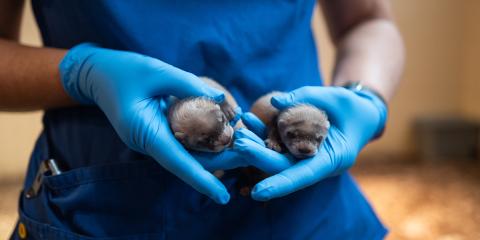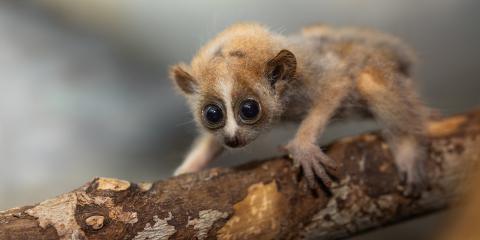Physical Description
Due to its forest habitat, clouded leopards have large, dexterous paws with specialized footpads for gripping branches. Specialized anklebones allow varied position for climbing, including climbing headfirst down trees. Another distinctive feature of the clouded leopard is its long canine teeth. These canines are longer in proportion to skull size than those of any other species of wild cat.
While more closely related to big cats, the clouded leopard is frequently described as bridging the gap between big and small cats due largely to its smaller stature. It has proportionately short legs and a long tail. The coat is brown or yellowish-gray and covered with irregular dark stripes, spots and blotches. Black and pale, whitish individuals have been reported from Borneo indicating the species may exhibit dark and albino forms.
While all species of cats are classified as one family, the Felidae, genetic research has shown the clouded leopard to be most closely related to the large cat species. Clouded leopards are not a "type" of leopard as their name implies. They are a separate species of wild cat, as are snow leopards and leopards. Recent research has proposed the clouded leopard branched from other members of the Pantherinae family first—over 6 million years ago—making them the most ancient feline species in the modern cat world.
Size
Males weigh up to 50 pounds (23 kilograms). Females are significantly smaller, usually 25 to 35 pounds (11 to 21 kilograms).
Native Habitat
The clouded leopard is found from Nepal, Bangladesh, and Assam (eastern India) through Indochina to Sumatra and Borneo, and northeastward to southern China and formerly Taiwan. Although population numbers are thought to be lower outside protected areas, their populations are probably healthiest in Borneo because of the absence of tigers and leopards. Clouded leopards prefer to live in lowland tropical rainforests. However, they can also be found in dry woodlands and secondary forests, and in Borneo, they are reported to live in mangrove swamps. They have even been spotted in the foothills of the Himalayas at an elevation of 9,000 feet (2,743 meters).
Lifespan
The average life span of the clouded leopard is 12 to 15 years, though they may live up to 17 years in human care.
Communication
Due to a different bone structure in their neck, the clouded leopard cannot roar like the larger cats, but also cannot purr because it lacks the fully ossified hyoid bone that allows small cats this ability. Vocalizations include growling, hissing and chuffing.
Food/Eating Habits
Like all wild cats, clouded leopards are carnivores. Their chief prey are gibbons, macaques, slow loris, small deer and wild boars, which they ambush from the trees or stalk from the ground. They may also hunt birds and rodents. Scientists once thought that clouded leopards mainly hunted from or in trees; current thought, however, is that while some hunting may occur in the trees, the majority most likely takes place on the ground. Although a relatively small predator, a clouded leopard can take down sizeable prey because of its strong legs, large canines and extreme gape (ability to open mouth to about 100 degrees).
At the Smithsonian's National Zoo, the clouded leopards are always fed separately to avoid aggression between individuals. They are fed a zoo carnivore diet called Natural Balance, which is ground beef that has been specially formulated to provide the proper nutrients such as calcium and taurine, important for prevention of metabolic bone disease. They receive this diet as the majority of their daily consumption twice a week. They also receive frozen-thawed rabbits twice a week, frozen-thawed rats twice a week, cooked chicken twice a week, and herring once a week. Twice a week, the clouded leopards get bones in addition to their regular meal, from which they lick out the cartilage and then chew on the bone, which is good not only for enrichment but also for their teeth and gums. Often, the cats receive their diet either in training sessions or in enrichment in the yard ‐ it is not uncommon to see bags, boxes or bungees where food has been hidden/attached in the clouded leopards' yard.
Sleep Habits
Clouded leopards are thought to be primarily nocturnal.
Reproduction and Development
Clouded leopards are sexually mature around 2 years old. Mating can occur in any month, but in human care, most breeding occurs between December and March. The gestation period is between 85 and 93 days with one to five cubs (usually two or three) produced per litter. Cubs' eyes open at 10 to 14 days. Teeth appear around three weeks. At 5 weeks, cubs leave the nest, and they are weaned at 90 to 100 days. Cubs are independent after 1.5 to 2 years. Females can produce a litter every year.
Like many cats, clouded leopards have various reproductive challenges. Most cat species are considered induced ovulators, meaning that the act of copulation induces the cat to ovulate. It is almost impossible to determine if this is true for clouded leopards due to their ability to spontaneously ovulate as well. Spontaneous ovulation is truly spontaneous and therefore can be unpredictable. About 50 percent of clouded leopards studied have been known to exhibit spontaneous ovulation, but not after every estrus cycle, so they are considered intermittent spontaneous ovulators. Due to this unpredictability, artificial insemination has been largely unsuccessful (only one successful insemination) up to this point. Scientists are working to suppress the clouded leopards' estrus cycle in order to induce ovulation at specified times which would potentially make artificial insemination more successful. In addition to the females' reproductive challenges, 70 percent of male clouded leopards have malformed sperm. Clouded leopards can exhibit pseudo-pregnancy.
Reproductive challenges aside, the biggest challenge in clouded leopard management in human care is mate compatibility. There is a high incidence of aggression between males and females, sometimes resulting in the death of the female. This fact has made clouded leopards one of the most difficult cats to breed in zoos and conservation centers. Unlike other large cats, pair formation in clouded leopards is most successful when the male is less than 12 months of age. Once paired, most clouded leopards in human care remain with the same mate for life. Formation of adult pairs, at least in human care, often results in injury or death of the female by the male; however, adult females can be paired successfully with immature males. Therefore, present management practices include introducing the members of a pair before 1 year of age, or a subadult male to a mature female. This practice has resulted in the establishment of more successful pair-bonds and lessening of aggression; however, it also limits the genetic variability. Additionally, present management practices also include hand-rearing all cubs due to low breeding numbers and high infant mortality.
Conservation Efforts
Clouded leopards are a vulnerable species. Although officially protected in most range countries, enforcement in many areas is weak. It is estimated that fewer than 10,000 mature individuals remain in the wild and no single population including more than 1,000 animals. Camera traps are helping scientists better estimate population numbers. The population in human care is around 70 and genetic diversity is presumed to be very low, with most individuals being related as closely as siblings and cousins.
Clouded leopards are victims of habitat destruction and illegal poaching. Their forest habitat is experiencing the world's fastest rate of deforestation. Clear cutting of forests for use as agricultural lands such as palm oil, is its primary threat, as the clouded leopard requires large tracts of forest for hunting. They are also widely hunted for their teeth, decorative pelt, and for bones for the traditional Asian medicinal trade.
Clouded leopard pelts are the most commonly seen pelts on the illegal market. In 2005, more than eighty clouded leopard pelts were for sale in one market in Myanmar (Burma). Restaurants in Thailand and China that cater to wealthy Asian tourists also feature clouded leopard meat on their menus.
Fewer than 10 clouded leopards in the wild have been radio-collared and studied; 90 percent of what is known about clouded leopards comes from research on captive populations. Much of the research involves collaborations between the Smithsonian's National Zoo, Khao Kheow Open Zoo in Thailand, The Zoological Parks Organization of Thailand and Nashville Zoo.
Biologists traditionally divided clouded leopards into four regional subspecies. In late 2006, a team of scientists including Smithsonian's National Zoo theriogenologist JoGayle Howard, found genetic evidence of two distinct species of clouded leopards. It is estimated that the two forms diverged about 1.4 million years ago. The new Sumatra/Borneo species has the common name of Sundaland Clouded Leopard and its scientific name is Neofelis diardi.
There is evidence that this species will be further divided into two distinct subspecies representing their origin: Neofelis diardi borneensis on the island of Borneo; Neofelis diardi sumatrensis on the island of Sumatra. This species is separate from Neofelis nebulosa, which retains three subspecies: N. n. brachyuras on the island of Taiwan (believed extinct in the wild); N. n. macrosceloides occupying northeast India, Nepal, Sikkim and Bhutan; N. n. nebulosa of southeast Asia and China. This is the type on the Zoo's Asia Trail.
Help this Species
- Support organizations like the Smithsonian’s National Zoo and Conservation Biology Institute that research better ways to protect and care for this animal and other endangered species. Consider donating your time, money or goods.
- Share the story of this animal with others. Simply raising awareness about this species can contribute to its overall protection.
Meet the Animals
Two clouded leopards, a male name Paitoon and a female named Jilian, live together on Asia Trail.


